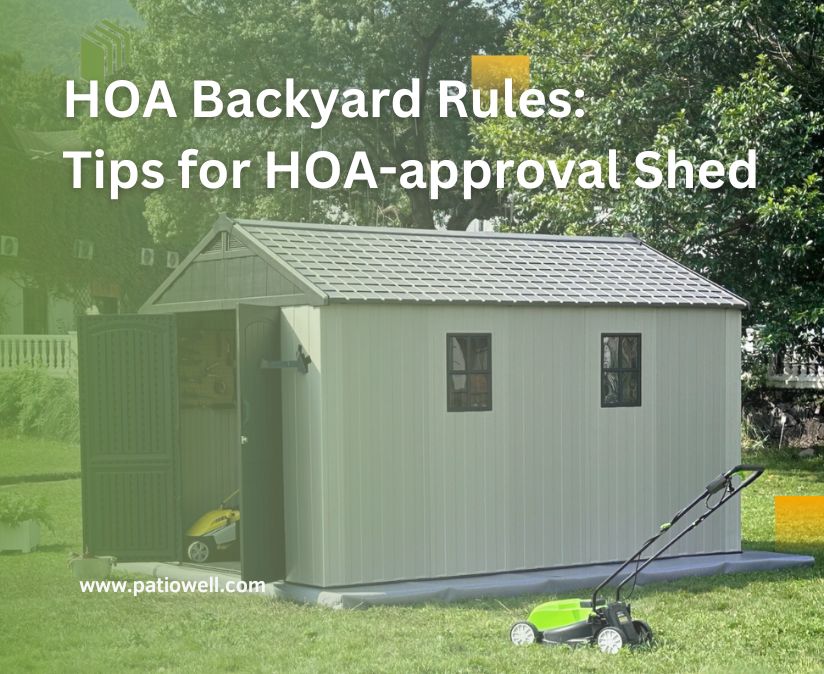Building a shed in your backyard can add valuable storage space, but adhering to HOA rules is crucial to avoid fines or penalties. Here’s how to ensure your shed meets HOA requirements.
Table of Contents:[hide]
What is an HOA and What Do They Do?
A Homeowners Association (HOA) is an organization that governs the rules and regulations within a residential community. HOAs are responsible for maintaining the aesthetic integrity of neighborhoods, managing community resources, and ensuring that any modifications, such as building a shed, comply with community standards. By enforcing these rules, the HOA helps protect property values and maintain a cohesive neighborhood environment. Familiarizing yourself with your HOA’s guidelines is essential to avoid unnecessary complications when adding new structures.
Find Your States and Local HOA Below
Before embarking on shed construction, it is crucial to consult your HOA for specific guidelines applicable to your area. Here are resources to help you find HOA contacts and rules for various states:
By reviewing these resources, you can ensure that your shed complies with both local zoning laws and HOA rules.
HOA Shed Rules to Follow for Shed Building
To avoid unnecessary hurdles and ensure your shed is HOA-compliant, there are several key regulations you must adhere to. These rules address various factors that affect the look and safety of your shed and, by extension, your entire property.
-
Obtain Approval
Before starting any construction, seek approval from your HOA. Most communities require homeowners to submit detailed plans outlining the proposed shed’s design, size, and materials for review. -
Material Restrictions
Many HOAs impose specific material requirements for sheds to ensure consistency with neighborhood aesthetics. Wood, vinyl, and metal are generally acceptable, but it’s important to confirm with your HOA regarding permissible materials.
Wood: Often allowed in most areas but may require regular maintenance or specific finishing to prevent decay.
Metal: Usually allowed but may be restricted in terms of color and style, especially in residential areas.
Resin/Plastic: Popular for their low-maintenance benefits, but color and style limitations are common in many neighborhoods.
Vinyl: Generally allowed, but some areas may have restrictions on their appearance, such as prohibiting bright or non-neutral colors.
Composite: Often allowed due to durability and low maintenance, though it may be subject to design restrictions in upscale areas.
-
Height Limitations
Height restrictions are enforced to maintain visual harmony and prevent obstruction of views. Typically, the height limit for sheds is between 10 and 12 feet, but this can vary depending on your HOA.
|
State |
Height Limitations |
Notes |
|
California |
10-12 feet |
Height may vary by city/county. Check local zoning codes for specifics. |
|
Texas |
10 feet |
Some areas may allow higher structures with a special permit. |
|
Florida |
12 feet |
Counties or cities may have lower limits for sheds near property lines. |
|
New York |
10 feet |
Some urban areas may have stricter restrictions. |
|
Nevada |
14 feet |
Height limitations are usually lower in residential areas. |
|
Colorado |
12 feet |
Typically allows sheds up to 12 feet, though some municipalities limit it further. |
|
Illinois |
10 feet |
Zoning laws may impose restrictions in urban or suburban areas. |
|
Georgia |
12 feet |
Some residential areas may impose stricter height restrictions. |
|
Ohio |
10-12 feet |
Local zoning or HOA rules may apply; varies by city. |
|
North Carolina |
12 feet |
Check local county or city rules for precise regulations. |
-
Shed Positioning
Sheds must be strategically placed on your property to avoid blocking views or encroaching on neighbor’s spaces. Often, they must be a set distance from property lines (usually 3-5 feet). -
Construction Quality
The construction quality of your shed is crucial. HOAs require that sheds be structurally sound and made from durable, long-lasting materials to ensure safety and appearance. -
Footprint Limitations
HOAs often place restrictions on the total square footage of sheds to prevent overcrowding or disrupting the property’s visual balance. Be sure to adhere to the footprint limits specified in your community guidelines.
How Do Zoning Laws Affect HOA-Approved Sheds?
Zoning laws, enforced by local governments, play a critical role in determining where and how you can build a shed. These laws govern aspects such as setbacks, size, and location within your property. Ensuring that your shed meets both HOA and zoning regulations is essential to avoid legal complications.
|
Service |
Description |
|
Find documents and applications for planning and zoning, construction specifications, strategic plans and more. |
|
|
The city of Springfield has begun its comprehensive update of Part 11 zoning code of Codified Ordinances. |
|
|
See and search a GIS map of zoning designations in the City of Springfield |
HOA Shed Building Restrictions
Here are 10 common restrictions that you must keep in mind when building a shed:
- Pre-approval from the HOA is mandatory before starting construction.
- Certain materials, like wood, vinyl, or metal, may be required.
- Shed height is often limited to 10-12 feet.
- Sheds must be placed at least 3-5 feet from property lines.
- Bright colors and unconventional designs may be restricted.
- Sheds cannot obstruct neighbors’ views or sunlight.
- A sturdy foundation is typically required (e.g., concrete slab).
- The shed cannot be used for commercial purposes.
- Sheds must complement the exterior aesthetic of the home.
- The shed’s square footage may be capped to prevent over-crowding.
By adhering to these restrictions, you can ensure that your shed remains compliant with HOA regulations and maintains the integrity of your neighborhood.
How to Choose an HOA-Approved Shed
Review your HOA’s rules regarding shed size, material, and color. Some associations require sheds to blend with the home’s exterior, while others may have strict guidelines on height or footprint.
Select the Right Size
Patiowell offers a variety of sizes, from the compact 4x4 plastic shed to larger options like the 12x12 metal shed. Ensure the shed you choose fits within your HOA’s size limitations. Smaller sheds are often ideal for smaller yards or more restrictive HOA rules.
Choose Suitable Materials
Depending on your HOA’s preferences, you may need a specific material. Patiowell’s plastic sheds are durable, low-maintenance, and generally fit within HOA guidelines for aesthetic appeal. For a more traditional look, opt for Patiowell’s metal sheds, which offer a clean, polished finish that’s often HOA-friendly.
Design and Color
Neutral colors and sleek designs are key to complying with HOA rules. Patiowell sheds come in various colors that blend well with most home exteriors, ensuring your shed complements your property while meeting HOA aesthetics.
What Happens if You Build a Shed Without HOA Approval?
Building a shed without HOA approval may seem like a quick fix, but it can come with significant consequences. Here’s what you could face:
-
Fines
HOAs are likely to impose daily fines for non-compliance. These fines can escalate quickly, becoming a heavy financial burden over time. -
Removal Orders
If the violation persists, you may be issued a removal order. You’ll be required to dismantle and remove the shed at your own expense, creating more hassle and unplanned costs. -
Legal Action
In extreme cases, your HOA could take legal action, resulting in costly lawsuits. This could drag on for months, leading to unnecessary stress and additional legal fees. -
Decreased Property Value
An unapproved shed can negatively impact your property value. Prospective buyers may be discouraged, or the shed may lower your home’s appraisal value, complicating future sales. -
Neighbor Tension
Ignoring HOA rules could also lead to strained relationships with neighbors. A non-compliant shed may disrupt the neighborhood’s aesthetic, causing complaints and unwanted friction.
To avoid these costly and stressful issues, always obtain HOA approval before you start building.
Conclusion
Building an HOA-approved shed is a straightforward process when you follow the necessary steps. By understanding the guidelines outlined in this article, you can avoid legal issues and enhance your backyard with a functional, aesthetically pleasing shed. Stay informed, plan ahead, and choose a shed that meets both your needs and your HOA’s requirements.
Diana Mason
Hi there! I’m Diana Mason, the chief editor of Patiowell brand. With over 15 years of diving deep into the world of outdoor furniture, I’ve developed a keen eye for what makes outdoor spaces truly special. I love sharing tips and inspiration to help you create your perfect backyard retreat. Our blog is a reflection of my passion and expertise, featuring only the best pieces that I personally vouch for. Thanks for stopping by—I can't wait to help you transform your outdoor living space!








Leave a comment
All comments are moderated before being published.
This site is protected by hCaptcha and the hCaptcha Privacy Policy and Terms of Service apply.